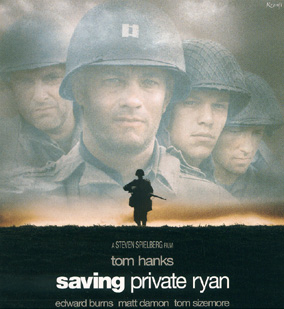
Office: HGH 210; phone: (408) 924-5378
Email: wooda@email.sjsu.edu
Web: http://www.sjsu.edu/faculty/wooda
 |
Dr. Andrew Wood Office: HGH 210; phone: (408) 924-5378 Email: wooda@email.sjsu.edu Web: http://www.sjsu.edu/faculty/wooda |
Owen, A. S. (2002). Memory, war, and American identity: Saving Private Ryan as cinematic jeremiad. Critical Studies in Media Communication, 19(3), 249-282.
Note: These comments are not designed to "summarize" the reading. Rather, they are available to highlight key ideas that will emerge in our classroom discussion. As always, it's best to read the original text to gain full value from the course.
 Susan
Owen begins her essay by noting the Vietnam Syndrome that contextualizes much
of contemporary American identity before offering an analysis of Saving
Private Ryan (SPR) as a secular jeremiad that offers a way home from contemporary
self-doubt. To that end, Owen defines the jeremiad as a rhetorical form that
names a covenant, laments its collapse, and prescribes its return [see notes
from COMM 149]. She also addresses a vigorous debate about whether, despite
their calls for change, jeremiads merely affirm the values of dominant culture,
“containing” all challenges into a conservative narrative.
Susan
Owen begins her essay by noting the Vietnam Syndrome that contextualizes much
of contemporary American identity before offering an analysis of Saving
Private Ryan (SPR) as a secular jeremiad that offers a way home from contemporary
self-doubt. To that end, Owen defines the jeremiad as a rhetorical form that
names a covenant, laments its collapse, and prescribes its return [see notes
from COMM 149]. She also addresses a vigorous debate about whether, despite
their calls for change, jeremiads merely affirm the values of dominant culture,
“containing” all challenges into a conservative narrative.
From this overview, Owen turns to post-Vietnam War cinema as
a site whether Americans encounter grief over U.S. involvement in that bitter
conflict. In many of these films (most notably, The Dear Hunter), “the
route to salvation lies in individual confession, mortification, and
martyrdom” (p. 254). Here, Owen discusses ways in which post-Vietnam
War cinema reveals American self-doubt, particularly that doubt related to white-masculinity.
In response, SPR offers a return to America’s mythic roots. In this manner,
Spielberg, “restores moral authority to the modern American nation-state”
(p. 259). Owen begins by noting how Ryan is introduced as an old man, surrounded
by fixed signs of duty -- a military cemetery and its flags. His personal doubts
(“Tell me I’m a good man”) must be assuaged by his wife, but
the American doubts that Ryan represents are already beyond dispute given the
setting of this scene. Owen then turns to how Spielberg privileges imagery (and
its production) over the “big speech” so typically required in other
war films. In SPR, the audience is forced to “witness”
scenes of carnage about which no words may be imagined. We do not witness from
the outside of the scene but as insiders, those who share responsibility for
what we see: “Through these techniques, we (the audience) are positioned
within the jeremiad” (p. 365). Once more, we are called to participate
reaffirm America’s mythic values.
Here, Owen turns to an analysis of Captain Miller’s complicated depiction
of post-Vietnam sensibility and then to an analysis of Spielberg’s resacrilizing
of the gun. In this first reading, Owen articulates Miller
as a post-feminist leader. After offering examples of this leadership
-- particularly recalling Miller’s response to a potential mutiny among
his ranks -- Owen notes, “As viewers, we recognize the conventionally
characterized ‘leader’ by his ability to inspire or intimidate men
into cooperation. To say the least, speeches of personal self-disclosure, self-reflection
and compromise -- in response to rebellion -- fall outside generic expectations”
(p. 267). Thereafter, Owen discusses Spielberg’s reconnection of the gun
and American moral purpose. As you might imagine, the sharpshooter becomes the
means for this resacrilization. The character of Private Jackson represents
American force exercised without doubt or guilt. As a result, “By transforming
the act of killing into an art form, traumatic memory of moral uncertainty,
atrocity, and defeat is displaced in favor of commemorative recollection of
righteous retribution, of victory” (p. 269). Both Owen and Jackson offer
a complete American myth, one that seems satisfied to forget its non-white male
components, one whose actions may be shaken now and again but are ultimately
affirmed in the higher good. Even so, Owen concludes by complicating the notion
that all jeremiads are necessarily conservative. She exits with a reminder that
the ruptures and struggles found in all hegemonic discourse contain the seeds
of genuine change, even if they must be secretly cultivated.
[Return to Syllabus]